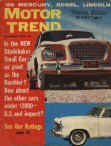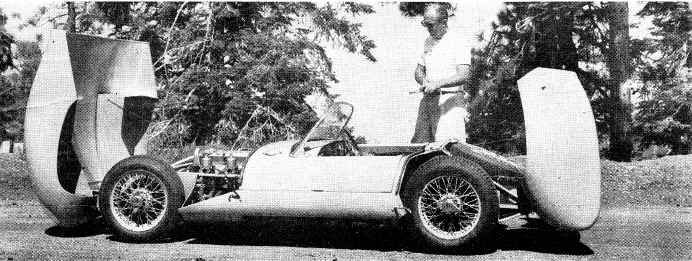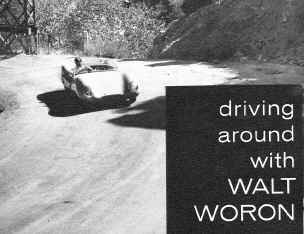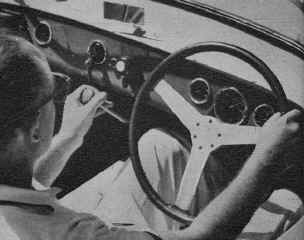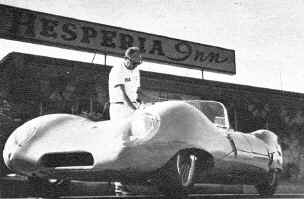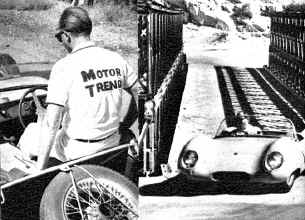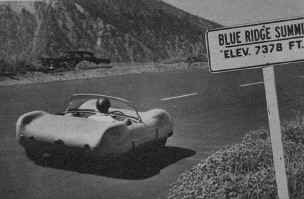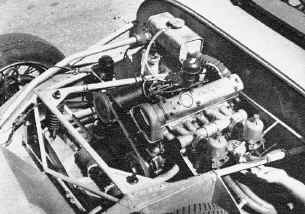|
Motor Trend December 1958
|
|
The LOTUS CLUBslight screamer |
|
|
|
|
|
LOW FRONTAL AREA is typical of all Lotus models
Seating is a tight fit; lightweight seats wedge driver into firm, comfortable position so that no safety belt is needed during hard cornering.
LOTUS CLUB performed best on open highway, climbed mountain roads with ease, giving 25-mpg economy on trip.
COVENTRY CLIMAX engine displaces 1100cc, has single overhead cam, develops 75 hp at 6250 rpm in this model.
|
DESPITE THE FACT that Lotus
"sportscars" have
been around on road racing circuits for several years now, few people
have seen them close up.
Fewer still know anything more about them than that "They're some
kind of a special, aren't
they?" Even in an area
as automotive-conscious as Southern California I was amazed at the questions asked,
like: "What
kind of a car is it?" "Did
you build that?"
"What kind of a body is it?" “What kind
of an engine does it have?"
"What country is that built in?" Of course
the people you meet on the street
are not the same ones who necessarily attend road races—aficionados who know that
the Lotus is a car that has carved a niche for itself in competition. In
the hands of the builder,
Colin Chapman, it began to appear
on road race circuits in 1953. Through its
growing pains, using different engines, including a two-liter Bristol, it racked up several
wins, including 11th place overall at Sebring,
1957, then fourth, sixth and ninth overall
at Sebring, 1958. New
versions of the Lotus are still appearing because of two reasons: Colin
Chapman strives to constantly improve the breed, and no
one car is run long enough without change.
That this is the policy of the Lotus Engineering
Co. (London, England) is evident in its brochures, which state, "In
accordance with the company's progressive policy,
the right to alter specifications without notice is reserved." My main
interest in the Lotus Club was to determine if you can take a sports-racing machine
like the Lotus Eleven and, without basic
alterations, make it into a street machine. The Le Mans model is the
original sports-racing
machine, having seating capacity for
only one, a built-in headrest-fin, and other minor
changes that are more suited for all-out racing, including a windshield
screen that wraps completely around the driver. The basic
differences between the Le Mans and Club models are these: The Club model has
a live rear axle from a Nash Metropolitan, located
by parallel trailing arms, with a diagonal
member to provide lateral location; the Le Mans model has a de Dion rear suspension
(The live axle on the Club model can
be replaced by a de Dion system at extra cost.)
The Club has hydraulically operated, two-leading shoe drum brakes: the Le Mans has
disc brakes, outboard at front, inboard at
rear. Both models have rack-and-pinion steering,
though on the Le Mans model it is lighter. Gearboxes are different only insofar as
ratios are concerned, the Le Mans having closer
ratios. Both weigh about 850 pounds. The
exceptional road qualities inherent in the Lotus Eleven Le Mans have
been carried forward into
the Club. These are mainly due to
the lightweight tubular frame, a sheet metal driveshaft tunnel that acts as a structural member to carry the
floor and the rear engine
mounts. The engine is tilted 10 degrees sideways so as to reduce frontal
area. Front suspension is
by swing axles, incorporating combined coil spring-shock units. The
roll center is very low and
greatly aids in its handling.
The basic difference in handling between
the Le Mans model and the Club is due to the latter's live rear axle. On rough roads
the Club has a tendency to wander, or walk
from side to side, taking real concentration to keep it in a straight
line. The de Dion rear
axle would more ably swallow up these
changes in road contour. Nevertheless,
the handling of the Club model
is quite wonderful. It has very quick Steering, has marvelous response and, of course,
would be easy to overcorrect if you're not
familiar with such a car. Taking it around
a turn, no matter how many degrees there
are, you never have to take your hands off the leather-wrapped wheel for there are only
1 ½ turns lock-to-lock. The engine
used in both Lotuses is virtually the same—the 1100cc Coventry Climax
four. This is an aluminum block engine with steel liners, an overhead cam driven by
chain from the crank. The crankshaft is fully
counterweighted, uses five bearings, and has
split connecting rods to enable their easy removal. The pistons are aluminum, combustion chambers are wedge-shaped,
and the compression ratio
is 9.8 to 1. Power output is
75 bhp at 6250 rpm or 83. at 6800 rpm, depending on the state of tune. To get back
to the question at hand, is it a street machine—or at least one that you could drive back and forth to work? Or is it
best for a competition driver who wants to
move up in class, and happens to have $4709
in loose change? Let me recount some of my experiences with it after
leaving Jay Chamberlain's
place in North Hollywood (the
U.S. distributor) until I returned it a week
later. Then you can decide for yourself. When you
first stand alongside this three-foot-high (at the windshield) machine
that fits into your
20-foot garage with more than four
feet to spare at either end, you get the impression of fragility. Never forget it! You'll
find that the aluminum body is virtually paper-thin. If you lean too
heavily on the body when
you're washing it, you're liable
to leave a dent. You have to make sure
you're not parked alongside someone who
opens his door suddenly, putting a nice crease in your side. You want to park it where
curious onlookers won't paw all over it
and give you handprints—handprints that are
outlined by the shape of the metal itself. You can get
into the car in one of two ways.
I found it was much easier to step directly over the side (which is only 24 inches
high) than to open the flap-down door—which
makes it a shorter height to step
over but increases the spread. If you have dirty shoes and clean clothes, the best method
is to lift up the seat cushion every time
that you get out; then when you step in
you keep the cushion—and your pants--clean. Once you're standing
inside, you then place
both feet on the floor, and shoehorn your
legs under the wheel. This is the only way
to get in. Otherwise, you'll find that one
leg is caught between the tunnel and the wheel, or between the door and the wheel .
. . and then you'll
have to start the procedure all over again. Starting was
easy enough once the battery situation on this particular car was cured. You
turn the key, punch the starter button, choke
it if necessary, but don't pump the throttle.
You don't let the engine idle too long, since there's no fan; the only cooling you
get is when you're moving and air rushes
through the radiator. In town
there is a definite tendency to overheat because of the lack of a fan. Several times
the temperature went over 100° C, but
a few minutes of running at normal road speeds
dropped the temperature back to normal.
The water won't boil away though, because the expansion tank catches the water that
would normally be boiling out. Since you
have to back out of the garage, you reach down to the gear lever on your left,
lift up, push over to the right, and drop
down into reverse. At first you'll find that
you'll be using both hands to do this, but as you get onto it you'll realize it's a
safety factor: there is no danger of dropping into reverse (alongside
fourth) when you make a snapshift from third to fourth. Incidentally,
the top three gears are synchromesh and the shift pattern is the normal
H, outside of the reverse
position. The driving position is quite nice, with the wheel in an almost straight-out arm position. The lightweight seats contour to your back and you're wedged down into a comfortable position. (There's no reason for seatbelts.) The pedal positions are good, with ample room between the clutch, transmission housing and steering column, and an equal amount of room for the brake pedal and throttle between the column and the side panel. The driveshaft tunnel traps heat from the engine and the transmission also gets fairly hot; it would be more comfortable if this section were padded. Watch those
water puddles! The water picked
up by the tires splatters onto the inside of the fenderwell and comes through the
seam where the rear section meets the driver's
compartment. For the same reason, take
it easy on dirt or on newly tarred sections. If you take
a trip and intend to carry any luggage or clothes other than those that you have
on, you'll find there is very little room. We
fitted the paraphernalia we carried on our
desert and mountain trip with the car into the two small door compartments, on the
ledges alongside the driver and passenger, and the rest on the passenger
floor. In this way we were able to carry our camera, briefcase,
clipboard, jackets, and stopwatches. For some
unaccountable reason the float bowl for the two S.U. carburetors sits between them,
and all three units are directly above the
exhaust headers. Even though a thin aluminum
sheet separates them, the heat from the headers, coupled with the underhood heat, results
in the gasoline percolating in the float
bowl. This, of course, held down both our
performance and gasoline mileage. Even so,
we got 25.1 miles per gallon on our mountain-desert-town course of 211 miles. Is the Lotus
Club a street machine? Personally, I look on it as a good base for
competition at moderate cost. It
has the performance, the
handling, and quick access to
parts that may need servicing. With the unsnapping of two spring hooks (one on each
side at the front) the hood and front fenders
lift as one unit, hinging forward. The
rear section opens the same way. Both can
also be lifted off their cam locks and laid aside. The Lotus
Club with 4.55 rear axle gives 16.7 mph for every 1000 rpm turned in high gear.
This means that at the maximum rev limit
of 7200, the car is capable of 120.2 mph
in top gear and 72.1 mph in third gear. Acceleration
is equal to the best sportscars in its category. The Club can turn 86 mph at
the end of a quarter-mile through the gears.
You can't get much better than that for
a sports-racing machine. It's light,
slight, but what a screamer! /MT |
| BACK to Design & Production | |
| HOME to www.lotuseleven.org | |
